In a surprising move, Netflix executives conveyed confidence on Thursday despite clear signals of turbulence in the broader economy. However, their full-year forecast reveals a much more complex narrative that can’t be overlooked. While they celebrated a substantial operating margin of 31.7% in the first quarter—surpassing the already optimistic analyst estimate of 28.5%—this triumph is overshadowed by caution. The guidance for the second quarter sits at 33.3%, which is ahead of the average forecast of 30%, indicating a fair level of optimism about immediate performance, yet this confidence seems superficial.
Long-term Projections: An Alarm Bell?
Netflix’s refusal to alter its long-term projections marks a significant signal of unease. The phrase, “no material change to our overall business outlook,” uttered in their shareholder letter, speaks volumes. The company appears to be bracing itself for potential headwinds as economic conditions worsen. Consumer sentiment in America, as it stands, is at an alarming low, resonating with fears stemming from unpredictable tariff policies. With such external pressures, Netflix’s future effectiveness in holding onto its subscriber base becomes questionable.
Resilience or Complacency?
Co-CEO Greg Peters touted Netflix’s historical resilience during economic downturns, labeling home entertainment as an affordable leisure option. But we must ask whether this so-called resilience is complacency masquerading as strength. An enticing monthly subscription starting at $7.99 may indeed seem like a bargain—until we consider that families and individuals facing tightened budgets may opt to forego streaming entertainment altogether. Netflix’s decision to stop reporting subscriber numbers adds another layer of opacity to its strategy, leaving investors and consumers in the dark about potential churn—a worrying prospect as economic woes escalate.
Revenue Numbers: What Lies Beneath?
In the first quarter, Netflix’s revenue of $10.5 billion aligned closely with analyst expectations, and the projected figure of $11 billion for the second quarter could suggest stability at a surface level. Yet it’s too simplistic to chalk this up to mere success. Retention rates may be stable and without significant shifts in plan types, but with economic pressures tightening your neighbor’s budget, what assurance do we have that subscriber loyalty can withstand the inevitable fallout of an economic slowdown?
A Glimpse into the Future
As Netflix navigates through these uncertain waters, the dialogue surrounding its business strategy becomes all the more intricate. Will they pivot to address a potential decline in consumer spending, or will they double down on their current model of aggressive content creation and subscriptions? The stakes are high, and while the platform thrives on the allure of original content, the looming question remains: how long can Netflix ride the wave of consumer loyalty before we see a substantial shift in dynamics? The entertainment landscape is evolving, and so is the fiscal landscape—Netflix’s fate in this intersection could write the next chapter in its storied presence.

